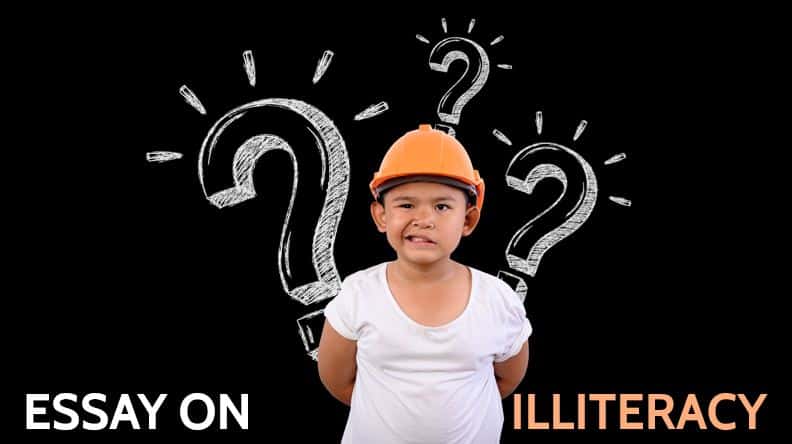- Skip to main content
- Skip to secondary menu
- Skip to primary sidebar
- Skip to footer
ImportantIndia.com
Indian History, Festivals, Essays, Paragraphs, Speeches.

Illiteracy: Meaning, Causes, Effects, Consequences and Solutions
Category: Social Issues in India On October 15, 2016 By Victor
What is the meaning of illiteracy?
Illiteracy is a state whereby one is unable to read and write. In its simplest form, it can be defined as lack of any or sufficient education.
Sometimes people who have had very basic education also experience challenges in reading and writing.
Illiteracy can also mean ignorance or the lack of knowledge in a specific subject. For example, a person may have gone to school but does not know how to operate a computer. Such an individual has no literacy in computer and is known as computer illiterate. Nearly every job advertised requires one to have computer literacy due to the digitization of most processes at the workplace.
A mistake in reading or writing that is seen to be characteristic of an illiterate person is also referred to as illiteracy. For this definition, a speech or letter that has several errors can be said to be full of illiteracies.
Functional illiteracy, on the other hand, is used to describe a situation where a person has writing and reading skills considered inadequate to perform employment duties that demand reading and writing skills that go beyond the basic level.
The challenges of illiteracy cut across: *Gender *Age *Race *Geographical location *Cultures
What are the causes of illiteracy?
There are so many reasons why an individual can be illiterate. These are some of the causes of the inability to read or write:
1. Illiteracy among parents: Many illiterate parents do not put much emphasis on the importance of education. Several of those born to parents who can neither read nor write end up being illiterate. This is especially true in remote areas where many people in the older generation have not gone through formal education. The reverse is true for those who have been brought up by parents with an elaborate educational background. They realize the necessity of taking their children to school and therefore ensure that they receive a good education.
2. Lack of family support: This can be the cause of illiteracy more so where a child has difficulty reading or writing because of dyslexia. In a situation where the family does not understand the child’s condition, it may simply be assumed that he or she is not a bright person and maybe school is not meant for everyone. Supportive family members help a child overcome reading disability and go through formal education with minimal challenges.
3. Unemployment of the educated: Some people believe that the only reason someone should go to school is so that he or she can get a good job and make a good life. Without the promise of employment, education is not a necessity to them. In a country where many of the educated are unemployed, there may not be enough motivation for the illiterate to go to school. After all, they reckon, why would you spend so much money paying for your education when there is no promise of a return on investment? In countries where those who have gone to school have good jobs and reasonable incomes, there may be sufficient motivating factors for people to get rid of illiteracy.
4. Lack of awareness: In places where several members of the local population do not understand why it is important for them to go to school, the level of illiteracy may be high. Disinterest in the benefits of formal learning can also be caused by lack of awareness on the importance of going to school. The number of illiterate people in urban areas tends to be lower than that of those in rural areas. People in towns are more aware of the need to eliminate illiteracy, the challenges that arise from lack of education and the social benefits of being literate compared to those who live in the remote place.
5. Social barriers: Many social barriers such as restrictions on girls’ education in some societies lead to illiteracy among the affected segment of the population. Education of the girl child has been an issue in some parts of the world leading to the formation of different organizations focused on championing the education of women. Forcing children into marriage is another social issue that causes illiteracy in the community. Family or social norms where female education is not allowed also causes illiteracy. In societies where the caste system is still in force, those who fall into the wrong caste may not get the opportunity to go to school. They are condemned at birth to remain illiterate.
6. Lack of affordable education facilities: Those who live in very remote areas with few or no education facilities may remain illiterate. The nearest school might be found several miles away. Instead of going through the tiresome process of walking for long distances on a daily basis just to go to school, many choose to stay at home. Lack of access to education facilities in rural areas has contributed a lot to the high number of illiterate people in these places.
7. Poverty: Poor parents with low incomes find it difficult to pay school fees. They are forced to choose between providing basic needs such as food, shelter and clothing and taking their children to school. In countries where basic education is not free, the number of children who do not go to school tends to be higher compared to places where basic education is free and mandatory.
What are the consequences and effects of illiteracy?
What are the consequences of Illiteracy? How does illiteracy affect the life of an individual and the society? These are some of the effects and consequences of the inability to read and write:
1. Hinders economic and social progress: Illiteracy greatly inhibits the economic and social progress of an individual as well as that of the country. Education gives one the power to seek opportunities and pursue them. People who have gone to school or are well educated have the expertise and intelligence to make good investment decisions and drive the growth agenda of a nation. Illiteracy, therefore, hinders the development of the country.
2. Poverty: Illiteracy leads to poverty. Education equips one with the right skills and expertise for gainful employment. A person who has not gone to school and is unable to read and write may experience a hard time in finding a job especially in a world where the corporate environment is increasingly in demand for employees who are well-trained and can cope with an industry driven by technology. Without a reasonable source of income, taking care of the dependent family members may prove to be difficult.
3. Child marriage: This is also a problem that may come about due to illiteracy. Parents may fail to recognize the benefits of taking children to school to learn how to read and write. Instead, the girl child may be forced into early marriage. It may also be a means of raising money through dowry payments to support the rest of the family members. In a way, the girl child is viewed as a property in some cultures. They can be traded to help the family make ends meet. The practice is especially rampant in areas where a lot of people have not gone to school.
4. Difficult life: An illiterate person can lead a difficult life in so many ways. The inability to find gainful employment can subject one to a life of poverty with poor living conditions. There can be a lack of basic necessities such as good shelter, clothing and decent meals. Illiteracy can also make one a societal misfit more so in areas where many people have gone to school and have the ability to read and write. Such a person can be the center of ridicule and suffer from stress and low self-esteem. Without the ability to read and write, it can be hard to read instructions which in some cases may have dire consequences. They say ignorance is bliss but that is not true when a person’s life is on the line.
5. Social crimes: Through education, a person can cultivate some civic sense and develop behavior patterns that are socially acceptable. Illiterate people may engage in unlawful acts in the society due to lack of employment or simply as a result of being uncultured. In countries where the number of those who have not gone to school is high, social crime levels also tend to be high.
6. Underpayment, Underemployment, Unemployment: We live in a world where the job market favors people who are properly educated with useful skills to drive company growth. Many illiterate people are thus underpaid, underemployed or unemployed. They are unable to earn income and in many cases perform a lot of duties with little pay.
7. Intergenerational Illiteracy: The issue of illiteracy can cut across generations within a family. It can become cyclic in such a way that even the third or fourth generation family members suffer the same fate. Intergenerational Illiteracy mainly comes about because education is given little to no value in the family setup. The children that come along will thus see illiteracy as the norm and not make any effort to learn how to read and write.
What are the possible solutions to stop or control illiteracy?
1. Free education: The provision of free education in schools, colleges, and universities by the government can play a major role in reducing the level of illiteracy in a country by getting more people to school. Since some people fail to attend school due to lack of money to pay for the fees, offering free education can increase the number of people attending school and subsequently reduce illiteracy levels within a society.
2. Awareness: Creating awareness about the importance of education can help people understand why they need to go to school. Non-governmental organizations, government agencies, and other concerned parties should put in place deliberate measures to create awareness in the society and reduce the number of people who are unable to read and write.
3. Grants: Offering grants, subsidies, and scholarships can reduce the financial burden that parents and students bear in paying for education. It would make it possible for students to learn without interrupting their education due to lack of school fees. Parents would also channel the money that would have been used to pay for school fees towards other income generating projects. The cost of financing education can prove to be too high especially for those who live in poverty.
4. Late night classes: Working people can opt for late night classes. In this way, they can learn even as they earn income through their daytime jobs.
5. Free books: The government and different foundations can offer free books in schools to encourage students to develop a reading culture. Offering free books can also reduce the financial burden placed on parents in the provision of textbooks.
6. Digitization: Since we live in the age of technology and information, creating digital platforms for reading and learning can help reduce illiteracy in the society. It can also help take care of the challenge of shortage of education facilities. Digital libraries can provide a good platform for those who live far away from urban centers to expand their knowledge base and become more informed.
7. Lower educational cost: Even though education has its rewards, it is very costly to finance. Many graduates usually leave school with huge debts in the form of student loans. It makes saving and investing difficult. The cost of university education has been a key political and social issue in many nations. By lowering the cost of education, the government can make it easier for people to study up to the highest level possible.
- History of Mughal Empire
- Modern History of India
- Important India
- Indian Geography
- Report an Article
- Terms of Use, Privacy Policy, Cookie Policy, and Copyrights.

Essay on Illiteracy for Students and Children in 1000 Words
In this article, you will read an essay on illiteracy for students and children. This persuasive essay includes its definition, situation, causes, solution and more.
So, let’s start this essay on illiteracy…
Table of Contents
Introduction (Essay on Illiteracy – 1000 Words)
Here you will read how illiteracy is a curse in today’s era. How day by day illiteracy is killing people, by making them unemployed, poor, and increased corruption in every field.
How illiterate people giving votes to unknown people and stopping the development of country. These are few examples of the situation, you will read more below in this article.
What is Illiteracy? – Its easy definition!
Illiteracy means ignorance and lack of knowledge. For example, a person goes to school but does not know how to operate a computer . Such a person has no literacy in computers, so he is illiterate in computer education.
But If a person or child does not take his education, and he doesn’t know reading and writing, thus he is an illiterate. And people tell this situation illiteracy.
Illiteracy in today’s era
Because of advanced technology and computer generation, people calling most of the old people who don’t know computer fundamentals as computer illiterate. Lots of village peoples still not able to read and write. Still, they are using their thumb stamp for various transactions and official works.
Today lack of adequate education not only makes people illiterate but also he will go 50 years back. As long as we do not educate them, they cannot read newspapers, circulars, notices , advertisements, posters and letters of dear ones.
Female population makes up a major portion of the total illiterate population . In India, the female literacy rate is around 65 percent and the male literacy rate is 82 percent according to 2001 census. Therefore, women education is very important to eliminate illiteracy.
We see illiteracy to be maximum in SC, ST and other backward classes which not only are poor but also unaware, uncertain and unwilling to make their improvements in life. Illiteracy not only deprives us of economic development but it deprives us from minor success in life.
Remarkably, the Government of India is showing awareness on this occasion and setting up thousands of primary schools across the country. Today in most of the villages of India you will see a Government Primary school.
Government with UNICEF also giving a daily meal in schools to motivate poor people to send their child to school. It is also helpful in solving various nutrition deficiency diseases in children. Despite this, the government has declared primary education as free in all government schools.
Causes of Illiteracy
1. uneducated parents.
Many illiterate parents emphasize little on the importance of education. Some parents of children are illiterate, who don’t know the importance of literacy.
Even today, there are some areas where many of the older generation have not even received an early education. So, we can say it still needs the root of education in India is still to be developed so that the tree of literacy will stands strongly.
2. Lack of family support
This also One reason for illiteracy can be so that where the child has difficulty reading or writing because of dyslexia, dysorthographia, etc… When the family understands the condition of the child. They do not get it, and children cannot get family support like this.
3. Poor family
Most of the poor family don’t send their child to school and college only because of lack of money. They could not pay a fee of the institute.
It is a major problem which happening in India during higher education of students. Not only poor but also middle-class families cannot pay an outrageous amount of fees asked from various institutions.
4. Lack of Books and other study materials
Some family only afford to educate their child but they can’t able to provide more and extra study materials to them. Which may cause school leaving and incomplete education of children’s.
Effects of Illiteracy
1. unable to read and write.
If an illiterate person unable to read and write he cannot reach his train seats, he will face difficulties everywhere. In this technology world, nothing work without education.
2. People will cheat him
The moneylenders and the landlords cheat them by stealing their lands. People exploits illiterate peoples. Illiterates face difficulties everywhere at home and also outside. Even people cannot use new machines because of illiteracy.
Solutions to Stop Illiteracy Efforts to Reduce Illiteracy
1. making education free.
The Constitution (Eighty-sixth Amendment) Act, 2002 has included Article 21-A in the Constitution of India as a fundamental right to provide free and compulsory education to all children between the ages of six to fourteen.
But if the government increased it to colleges and university levels, it would make the country more independent by making more people literate.
Since some people cannot enroll their children in school because of lack of money to pay fees. Hence offering free education can increase the number of people attending school and subsequently reduce the level of illiteracy in the society, thus incorporating this rule under the Right to Education in the Indian Constitution in the year 2003.
2. Awareness
Creating awareness about the importance of education can help people understand that they need to go to school. Many non-governmental organizations, government agencies and other related parties should create literacy awareness in the society.
3. Scholarships
Providing grants and scholarships can reduce the financial burden of poor and middle-class people to educate their children. Because of which there is some reduction in the school fees, so that the education of the students will complete without hindrance.
4. Night Classes
People who are workers can attend night classes. In this way, they complete their education and earn income through day jobs.
5. Free Books
Government can provide free books in schools to encourage and students to develop reading culture. Offering free books can also reduce the financial burden of their parents.
Not only the government but every educated people’s effort can eradicate illiteracy. Every effort made by all educated people can help to eliminate this danger from the root.
We should educate every person in India. Going to school plays a major role in mental and social development of a person. I hope you liked this persuasive essay on illiteracy.
Leave a comment Cancel reply
%20(1).png)
- May 31, 2022

Hidden in Plain Sight: The Secret Epidemic of Illiteracy in the United States
America has a literacy problem, and it’s worse than you think.
Amelia Lake | [email protected]
The ability to read is an essential skill for navigating the modern world, yet millions of adults in the United States have such poor literacy skills that they are unable to read basic sentences, fill out a job application form, or understand the instructions on their prescription labels. Without intervention, illiteracy has wide-reaching and devastating consequences, condemning its sufferers to shame, isolation, and poverty. Kirsten Levinsohn, executive director of New Haven Reads, a New Haven-based organization that works to foster children’s literacy skills, explains current legislative and community efforts to address this issue.

Text messages. Emails. News articles. Road signs. There is a good chance that you have encountered one of these things today, and odds are, decoding them from letters, to words, to meaning took about as much effort as breathing. The ability to read is something the majority of us take for granted, and yet it is one of the most fundamental skills needed to navigate and be successful in our modern world. But for all too many people—maybe some you know—it is an insurmountable barrier and a source of deep shame.
The numbers are staggering. As of 2022, ThinkImpact reports that an estimated 79% of American adults are literate. To put it another way, one out of every five American adults are functionally illiterate, meaning that today in the United States, almost 65 million people are unable to read basic sentences, fill out a job application form, or understand the instructions on their prescription labels. This is not merely a crisis of the illiterate, but also of the underliterate: a whopping 54 percent of all American adults read at or below a sixth grade level.
“Literacy is a basic human right,” says Kirsten Levinsohn , executive director of the New Haven-based nonprofit New Haven Reads. “Reading is fundamental. You can’t be successful by any measure if you don’t first learn to read…It’s easy not to think about it, especially if it doesn’t impact you. But it’s a tragedy for every child who doesn’t learn how to read, and it’s a tragedy for the family, the community, and the state as well.”
The root of the problem is in early childhood. All too often, students who perform poorly in school are allowed to fall through the cracks. Without proper access to services that can help a struggling reader or identify an undiagnosed reading disability early on, children who are most in need of intervention are simply passed over. “If you haven’t been taught how to read before third grade,” says Levinsohn, “it’s unlikely that you ever will, because teachers are moving on. You miss the transition from ‘learning to read’ to ‘reading to learn’.”
The social and economic toll is nothing short of devastating. Starting in school, illiteracy leads to feelings of inadequacy, shame, and isolation. Students with low levels of literacy are more likely to be chronically absent, suffer behavioral problems, and drop out of school, leading to a cascading chain reaction of negative consequences. Literacy Mid-South estimates that high school dropouts , lacking employment prospects, are almost four times more likely to be arrested and 63 percent more likely to be incarcerated than their peers. The burden is lifelong, with morbid outcomes—illiteracy has strong links to poverty , with some 43 percent of illiterate adults living under the poverty line, and a reduced ability to access health services. According to a study by Nursing , elderly individuals who are illiterate are more likely to die within 6 years than those who can read well enough to understand basic health information.
This suffering is not felt evenly across the board. Illiteracy is strongly generational, meaning that individuals who are illiterate are much more likely to have been raised by illiterate and undereducated parents. “Some people say, ‘Oh, the kids can’t read because the parents don’t care,’ ” says Levinsohn. “First of all, the parents do care. They care a lot—they just don’t have the opportunities that higher-earners have access to.” Indeed, family wealth, along with parental literacy level, is among the strongest predictors of a child’s academic success. According to Regis College , exposure to literature—specifically, being read to and having access to age-appropriate books—is a critical part of fostering a child’s reading skills outside the classroom. Yet more than half of all American families living in poverty (who are disproportionately likely to be people of color, rural, Indigenous, or foreign-born) do not have children’s books in the home. Low-income earners, facing additional financial stress and grueling working hours, have less energy and time to engage in their child’s education. As the saying goes, you don’t know what you don’t know, and this is no less true when it comes to education; illiterate adults often lack the knowledge to recognize when their child is falling behind. The end result is that parents who themselves are illiterate, through no fault of their own, are simply ill-equipped to properly support a child’s academic development.
Says Levinsohn, “what’s happening now in Connecticut is that there are huge gaps in reading attainment, often having to do with disparities in income and race, which reflect the inequities in our society. In New Haven right now, about 30 percent of kids are reading at grade level or better—which, if you say it the other way, means 70 percent aren’t, which is horrendous.”
It is worth noting that these statistics are all pre-pandemic. With school closures interrupting the education of millions of students, the situation has only worsened.
The blame lies partly in curriculum design. “This is not to bash teachers,” says Levinsohn, a former teacher herself. “They went into this field for a reason. They’re all working so hard. But not all of them have been trained in the science of reading, and the science of reading is not universally accepted.”
Levinsohn is referring to the so-called “reading wars” , an ongoing debate over how reading should be taught. This rivalry, which dates back to the 1800s, consists of two opposing schools of thought: whole-language and phonics. Proponents of whole-language theory see learning to read and write English as analogous to learning to speak—“a natural, unconscious process” that is best taught through “unstructured immersion”. Words are taught individually, much like Chinese characters, and children are encouraged to decipher their meaning through context clues. Phonics, on the other hand, sees written language more as a code to be deciphered. This method emphasizes phonemic awareness, meaning that it teaches children to identify the constituent sounds of words to sound them out. Despite overwhelming evidence that the phonics approach leads to better reading outcomes, there is no federal requirement for schools to implement it in their curricula.
For the past 20 years, there has been little change in reading outcomes. As Levinsohn puts it: “Obviously, doing the same thing over and over is not working.”
The “ Right to Read ” Act, passed last June by the Connecticut General Assembly under the sponsorship of Senator Patricia Miller, aims to close some of the gaps. With its $12.8 million budget, the bill makes provisions to ensure school districts can hire reading coaches for students who are falling behind. Furthermore, it establishes a Center for Literacy Research and Reading Success, which will oversee the development of reading curricula for students in grades PreK-3. Its focus is, in part, on ensuring that school districts—which previously had complete autonomy in designing their reading curricula—adhere to evidence-based practices of reading instruction. “There is a proven method for literacy instruction,” wrote Miller in an opinion piece for the Stamford Advocate, “and that we need to use it in all of our Connecticut classrooms. Our students are entitled to it.”
Levinsohn is optimistic about the bill’s potential. “It just needs to become a priority,” she says. “There needs to be money and resources at the lowest level so kids are getting the support they need.”
But legislation isn’t the only means of intervention. Community-based organizations like New Haven Reads can and do have a tremendous impact . The nonprofit, initially founded as a book bank, has been a part of the New Haven community for over 20 years and offers a number of programs intended to support literacy development in struggling children. Prior to the Covid-19 pandemic, it sponsored school field trips for grades PreK-5 where students got to pick out five books to take home with them. “Unfortunately, a lot of kids don’t have books at home, or maybe they only have one or two,” Levinsohn explains. “We really try to put out books that would be at their grade level and their interest level. We also try very hard with this program and our tutoring program to have books that are diverse and have characters that represent our child readers.” All in all, New Haven Reads donates over 100,000 books a year , and has donated almost 2 million since its founding.
While the pandemic has forced New Haven Reads to temporarily shutter some of its usual activities, “we are still giving out books,” says Levinsohn. “Frankly, a lot to teachers. A lot of them don’t have books in their classrooms, which is quite sad. And even more sad is that a lot of schools have had to close their libraries for financial reasons, so the kids have less access to books.”
In addition to its book bank, New Haven Reads also offers a one-on-one tutoring program, which trains volunteers and matches them with a student with the intention of creating a long-lasting partnership. The program, which serves about 600 children per week, relies on the support of its roughly 400 volunteer tutors, many of them Yale affiliated—students and faculty alike. “For most of the children who come to us, all they need is a little extra individualized help,” Levinsohn says. “A lot of it is confidence for these kids. They feel that they’re stupid if they can’t read, and it’s so far from the truth. To see them grow and become more confident, it’s amazing.”
Despite the squeeze of the pandemic, New Haven Reads only intends to expand its array of services. In the works is an upcoming program intended to serve recent immigrants through a partnership with Integrated Refugee & Immigrant Services . And volunteers are always welcome.
“It’s the community at its best,” says Levinsohn. “It’s people from all walks of life coming together to support our city’s greatest asset—our kids.”
Writer’s reflection:
As a lover of language and a passionate learner, it’s difficult for me to fathom what it must be like to navigate everyday life, never mind education or work, without the ability to read. Yet for millions of Americans—our community members, friends, maybe even our own family—that is their reality. I want to extend my sincerest thanks to Kirsten Levinsohn for sharing her knowledge with me, and encourage readers to consider volunteering or donating to New Haven Reads and other organizations doing important work to tackle this issue.
- 2022 Spring Issue
- United States
Recent Posts
Breathing as a Human Right: Cancer Alley as a Case Study of Environmental Racism
The State of Reproductive Rights in Latin America-Ripples and Rollbacks
Resettlement and the Road Ahead
Comentários
Home — Essay Samples — Education — Academic Concerns — Illiteracy
Essays on Illiteracy
Cause and effect of illiteracy, the problems of illiteracy pakistan is facing today, made-to-order essay as fast as you need it.
Each essay is customized to cater to your unique preferences
+ experts online
A Study of The Illiteracy Effect in The Book of Eli and Learning to Read and Write by Frederick Douglass
The rising concern of illiteracy in the u.s and the benefits of educating kids, how education impacted frederick douglass's life, a study at how the constitution can help to improve cases of illiteracy in mexico, let us write you an essay from scratch.
- 450+ experts on 30 subjects ready to help
- Custom essay delivered in as few as 3 hours
Telecom: The Answer to Pakistan’s Legal Illiteracy
Education was a key for frederick douglass's freedom, adult education program: literacy center, issues and problems involved in adult education program in pakistan, get a personalized essay in under 3 hours.
Expert-written essays crafted with your exact needs in mind
The Main Causes of Illiteracy
Causes and effects of illiteracy, relevant topics.
- School Uniform
- Academic Challenges
- Inequality in Education
- Academic Dishonesty
- Academic Interests
- Critical Thinking
- Importance of Education
- High School
By clicking “Check Writers’ Offers”, you agree to our terms of service and privacy policy . We’ll occasionally send you promo and account related email
No need to pay just yet!
We use cookies to personalyze your web-site experience. By continuing we’ll assume you board with our cookie policy .
- Instructions Followed To The Letter
- Deadlines Met At Every Stage
- Unique And Plagiarism Free

Monday 20 February 2017
Illiteracy in pakistan - causes, impacts and solutions - english essay.

CAUSES OF ILLITERACY
Impacts of illiteracy, solution of illiteracy, i. awareness about problem: , ii:attitude change: , iii. literacy programs., iv. free educational items: , v. increase the importance of education: , vi. change the mindset:, you may also like:.

About Maher Afrasiab
Hello, I am Maher Afrasiab a founder of Ratta.pk and some other websites. I have created ratta.pk to promote the eductaion in Pakistan. And to help the students in their studies. Find me on Facebook: @Maher Afrasiab
10 comments:

- English Learning Notes
- History Notes
- English Essays
- General knowledge
- Guess Papers
Illiteracy and its Solutions(330 words), please give me feedback for my essay.
Illiteracy and its Solutions
Illiteracy is one of the problems which we have to find solution for. The ratio of illiteracy varies from country to country. Regardless, it still is a problem. There are some kinds of illiteracy such as disability in writing and reading, and a person who is unable to use the Internet is illiterate as well. You are you going to discover three of the best solutions for illiteracy in this reading. I will talk about opening new schools, creating TV and radio channels, and offering rewards for people who join school and finish their educational program.
First, as we know, it’s difficult for persons in their 40s or 60s to use the same educational method which is used for children. Therefore, we have to systematize new special ways, special schools and special teachers who have ability to teach illiterates effectively. Opening modern training centers can start this plan. Using technology and modern education theories helps everyone inside the educational progress.
The news solution is creating special channels. Whether using TV channel , radio ,the Internet or both together, any kind of media has a strong effect on people. Nowadays, channels can persuade illiterates to go to school and learn writing and reading. Furthermore, it can teach them basic reading, writing and calculation skills.
Third , offering rewards and prizes. As a matter of fact, most illiterates are poor, because of this they couldn’t go to school when they were children. They thought getting job is more important than learning in school. Prizes can convince them to go to school and start learning. We can customize this idea through terms such as finishing special programs.
We will never see any great change in few years, it takes much more time. We have to cooperate to clear this problem which is holding back. I recommend researches illiteracy, and creative solutions. I recommend governments to wag a truthful war against illiteracy. I think this is what would make a better world.
TOEFL listening lectures: A university lecture by a Drama professor
Illiteracy is one of the problems which we have to find A solution for. The ratio of illiteracy varies from country to country. Regardless, it still is a problem. There are some kinds of illiteracy such as disability in writing and reading, and a person who is unable to use the Internet is illiterate as well. You are you going to discover three of the best solutions for illiteracy in this reading. I will talk about opening new schools, creating TV and radio channels, and offering rewards for people who THE join school and finish their educational program.
First, as we know, it’s difficult for persons in their 40s or 60s to use the same educational method which is used for TODAY’S children. Therefore, we have to systematize new special ways, special schools and special teachers who have ability to teach illiterates effectively. Opening modern training centers can start this plan. Using technology and modern education theories helps everyone /inside the/INVOLVED IN/ educational progress.
The NEW solution is IN creating special channels. Whether using TV channel, radio, the Internet or both together, any kind of media has a strong effect on people. Nowadays, channels can persuade illiterates to go to school and learn writing and reading. Furthermore, it can teach them basic reading, writing and calculation skills.
Third, offering rewards and prizes. As a matter of fact, most illiterates are poor, because of this they couldn’t go to school when they were children. They thought getting A job WAS more important than learning in school. Prizes can convince them to go to school and start learning. We can customize this idea through terms CONDITIONS such as finishing special programs.
We will never see any great change in ONLY A few years, it takes much more time. We have to cooperate to clear this problem which is holding EVERYONE back. I recommend researches INTO illiteracy, and creative solutions. I recommend governments to wagE a truthful war against illiteracy. I think this is what would make a better world.
Good morning Fisal. I found your work both interesting and amusing. What I would now like to see is a counter-argument to your claim.
Kitos. 8.5/10
Soviet Band of ‘Vigilantes’ Is a Youth Gang Known for Beating Nonconformists
- Show more sharing options
- Copy Link URL Copied!
A gang of thugs was suddenly thrust into the spotlight this week when Soviet officials said gang members, who they called “vigilantes,” broke up demonstrations by dissidents.
The gang, named “Lyubers” after the Moscow suburb Lyubertsy where most of them live, roams the streets of the capital at night, beating punk rockers and other nonconformist teen-agers and robbing black marketeers.
According to press accounts, Lyubers mix Russian nationalism with right-wing philosophy, body-building and martial arts. The gang “uniform” consists of voluminous checked pants, tight white shirts and narrow black ties.
‘Vigilantes’ Blamed
On Thursday, a Foreign Ministry spokesman, Gennady I. Gerasimov, said “home-grown vigilantes,” apparently from the Lyubers gang, not plainclothes security agents, were responsible for roughing up demonstrators seeking emigration rights and the release of a Jewish activist from prison.
It was clear at the scene that the burly men who beat the demonstrators and some Western reporters were not teen-age thugs, but agents backed by police and the KGB secret police.
However, it was very unusual for a Soviet official to acknowledge the existence of such a gang, especially in a news briefing for Western reporters. Teen-age gangs are nothing new to Moscow, but they have rarely been given any attention in the official press.
Opposed to Hippies
The magazine Ogonyok said in a recent article that Lyubers are opposed to nonconformist youths, including hippies, punk rockers, heavy metal fans known as metallists and break dancers.
“Hippies, punks and metallists shame the Soviet way of life,” gang member Boris Taranov, 17, told Ogonyok. “We want to clean them out of the capital.”
The magazine said police know about the activities of the Lyubers but have not been able to take action “for the simple reason that hippies, punks and metallists who have suffered from the Lyubers don’t go to the police.”
The magazine said many Lyubers seem to believe in this “philosophy” but others simply use it as an excuse to beat and rob fellow Muscovites, especially black marketeers who usually carry large sums of money.
No Estimates of Size
There are no estimates on the size of the gang. A gang leader, asked by an Ogonyok reporter how many people he could assemble in a few hours, said a conservative estimate was 200.
The gang members practice boxing, wrestling, judo, karate and weightlifting in basement gymnasiums built from the proceeds of selling stolen goods, Ogonyok said.
“Lyubers practically don’t drink, they don’t smoke and as far as we know, they don’t take drugs,” reporter Vladimir Yakovlev wrote in an article for the magazine.
More to Read

The real story behind that photo of a weirdly unscathed house in the rubble of Lahaina
Aug. 18, 2023

Mob in Mexico beats kidnapping suspect to death hours before Holy Week procession
March 29, 2024

Ex-Trump White House official reports to prison to serve contempt of Congress sentence
March 19, 2024
Start your day right
Sign up for Essential California for news, features and recommendations from the L.A. Times and beyond in your inbox six days a week.
You may occasionally receive promotional content from the Los Angeles Times.
More From the Los Angeles Times

World & Nation
Israeli Prime Minister Netanyahu to undergo hernia surgery

Israeli airstrike hits Gaza hospital tent camp, killing 2 Palestinians and wounding journalists

Pope overcomes health concerns to preside over Easter Sunday Mass in St. Peter’s Square

In Indonesia, deforestation is intensifying disasters from severe weather, climate change
March 31, 2024
MiG 3 main list +

Mikoyan Gurevich MiG 3 172IAP For the Party of Bolsheviks with Nikolai Sheyenko May 1942 01
Mikoyan-Gurevich MiG-3
National origin:- Soviet Union Role:- Fighter Interceptor Manufacturer:- Mikoyan-Gurevich Designer:- First flight:- 29th October 1940 Introduction:- 1941 Status:- Retired 1945 Produced:- 1940-1941 Number built:- 3,422 Primary users:- Soviet Air Forces (VVS); Soviet Air Defence Forces (PVO); Soviet Naval Aviation Developed from:- Mikoyan-Gurevich MiG-1 Variants:- Mikoyan-Gurevich I-211 Operational history MiG-3s were delivered to frontline fighter regiments beginning in the spring of 1941 and were a handful for pilots accustomed to the lower-performance and docile Polikarpov I-152 and I-153 biplanes and the Polikarpov I-16 monoplane. It remained tricky and demanding to fly even after the extensive improvements made over the MiG-1. Many fighter regiments had not kept pace in training pilots to handle the MiG and the rapid pace of deliveries resulted in many units having more MiGs than trained pilots during the German invasion. By 1 June 1941, 1,029 MIG-3s were on strength, but there were only 494 trained pilots. In contrast to the untrained pilots of the 31st Fighter Regiment, those of the 4th Fighter Regiment were able to claim three German high-altitude reconnaissance aircraft shot down before war broke out in June 1941. However high-altitude combat of this sort was to prove to be uncommon on the Eastern Front where most air-to-air engagements were at altitudes well below 5,000 metres (16,000 ft). At these altitudes the MiG-3 was outclassed by the Bf 109 in all respects, and even by other new Soviet fighters such as the Yakovlev Yak-1. Furthermore, the shortage of ground-attack aircraft in 1941 forced it into that role as well, for which it was totally unsuited. Pilot Alexander E. Shvarev recalled: "The Mig was perfect at altitudes of 4,000 m and above. But at lower altitudes it was, as they say, 'a cow'. That was the first weakness. The second was its armament: weapons failure dogged this aircraft. The third weakness was its gunsights, which were inaccurate: that's why we closed in as much as we could and fired point blank." On 22 June 1941, most MiG-3s and MiG-1s were in the border military districts of the Soviet Union. The Leningrad Military District had 164, 135 were in the Baltic Military District, 233 in the Western Special Military District, 190 in the Kiev Military District and 195 in the Odessa Military District for a total of 917 on hand, of which only 81 were non-operational. An additional 64 MiGs were assigned to Naval Aviation, 38 in the Air Force of the Baltic Fleet and 26 in the Air Force of the Black Sea Fleet. The 4th and 55th Fighter Regiments had most of the MiG-3s assigned to the Odessa Military District and their experiences on the first day of the war may be taken as typical. The 4th, an experienced unit, shot down a Romanian Bristol Blenheim reconnaissance bomber, confirmed by postwar research, and lost one aircraft which crashed into an obstacle on takeoff. The 55th was much less experienced with the MiG-3 and claimed three aircraft shot down, although recent research confirms only one German Henschel Hs 126 was 40% damaged, and suffered three pilots killed and nine aircraft lost. The most unusual case was the pair of MiG-3s dispatched from the 55th on a reconnaissance mission to PloieÅŸti that failed to properly calculate their fuel consumption and both were forced to land when they ran out of fuel. Most of the MiG-3s assigned to the interior military districts were transferred to the PVO where their lack of performance at low altitudes was not so important. On 10 July 299 were assigned to the PVO, the bulk of them belonging to the 6th PVO Corps at Moscow, while only 293 remained with the VVS, and 60 with the Naval Air Forces, a total of only 652 despite deliveries of several hundred aircraft. By 1 October, on the eve of the German offensive towards Moscow codenamed Operation Typhoon, only 257 were assigned to VVS units, 209 to the PVO, and 46 to the Navy, a total of only 512, a decrease of 140 fighters since 10 July, despite deliveries of over a thousand aircraft in the intervening period. By 5 December, the start of the Soviet counter-offensive that drove the Germans back from the gates of Moscow, the Navy had 33 MiGs on hand, the VVS 210, and the PVO 309. This was a total of 552, an increase of only 40 aircraft from 1 October. Over the winter of 1941-42 the Soviets transferred all of the remaining MiG-3s to the Navy and PVO so that on 1 May 1942 none were left on strength with the VVS. By 1 May 1942, Naval Aviation had 37 MiGs on strength, while the PVO had 323 on hand on 10 May. By 1 June 1944, the Navy had transferred all its aircraft to the PVO, which reported only 17 on its own strength, and all of those were gone by 1 January 1945. Undoubtedly more remained in training units and the like, but none were assigned to combat units by then.

Send Mail Please help us to improve these articles with any additional information or photo's. If you should encounter any bugs broken links, or display errors just email us.
If you love our website please add a like on facebook
Please donate so we can make this site even better !!
This webpage was updated 2nd August 2021

IMAGES
VIDEO
COMMENTS
These are some of the effects and consequences of the inability to read and write: 1. Hinders economic and social progress: Illiteracy greatly inhibits the economic and social progress of an individual as well as that of the country. Education gives one the power to seek opportunities and pursue them. People who have gone to school or are well ...
It is defined as the inability to read and write, and it has significant negative effects on individuals and societies. Illiteracy can be caused by a variety of factors, and its consequences can be far-reaching. In this essay, we will explore the causes and effects of illiteracy, as well as potential solutions to this global problem.
Introduction (Essay on Illiteracy - 1000 Words) Here you will read how illiteracy is a curse in today's era. How day by day illiteracy is killing people, by making them unemployed, poor, and increased corruption in every field. How illiterate people giving votes to unknown people and stopping the development of country.
Economic Impact. The World Literacy Foundation (2018) reported that illiteracy and low levels of literacy have estimated to cost the global economy approximately £800 billion annually. Specifically, in the UK, illiteracy costs their economy around £80 billion in 2018 due to costs associated with welfare, unemployment, and social programs, as well as reduced government tax revenue and ...
The causes of illiteracy are complex and interrelated. Poverty, for instance, plays a significant role in perpetuating illiteracy. Families struggling to meet basic needs may prioritize immediate survival over education, leading to limited access to schooling and resources. Lack of access to quality education in impoverished communities results ...
Adult illiteracy directly affects an individual's employment options, likelihood to live in poverty, likelihood to be incarcerated, access to adequate health care and health outcomes, and life ...
Illiteracy The inability to read or write. has many negative impacts on individuals and society. Overall, low literate adults participate less in the labor force, earn less, and are less likely to read to their children, which may stunt their children's literacy Understanding, evaluating, using, and engaging with written text to participate in society, to achieve one's goals, and to ...
The numbers are staggering. As of 2022, ThinkImpact reports that an estimated 79% of American adults are literate. To put it another way, one out of every five American adults are functionally illiterate, meaning that today in the United States, almost 65 million people are unable to read basic sentences, fill out a job application form, or understand the instructions on their prescription labels.
Causes and Effects of Illiteracy. Illiteracy, the inability to read and write, remains a persistent challenge in many parts of the world, exacerbating socio-economic disparities and hindering personal development. This essay delves into the causes and effects of illiteracy, exploring the multifaceted factors contributing to this issue and the ...
The good news is that illiteracy is a solvable problem, and the partner organizations that we work with can "cure illiteracy". There is hope for everyone, and it begins with the first step—linking up with an adult literacy organization. Phone: 716.651.0465. Fax: 716.651.0542.
Solution Exploration: Offer potential solutions to address illiteracy and its consequences, demonstrating a broader perspective on how to mitigate its effects. Grammar and Clarity: Review the essay for grammatical errors and improve sentence structure to enhance overall readability.
Illiteracy in Pakistan - Causes, Impacts and Solutions - English Essay. Illiteracy has been defined as reading a paragraph of a language with understanding according to the census of Pakistan 1981. The literacy rate is about 45% and the rest of the people 55% are illiterate according to 1998 census of Pakistan.
Niger, a country in West Africa has one of the lowest literacy rates in the world. According to a 2019 study by the World Population Review, Niger has a literacy rate of 19. 10%. Niger's economy is also one of the worst in the world. Niger's economic freedom score is 51. 6, making its economy the 151st freest in the 2019 Index.
The literacy rate in Pakistan is about 59. 9% which basically means that almost 40. 1% of Pakistani population is illiterate. The main cause for this high percentage of illiteracy proves to be the poverty. Even after a number of measures taken by government the government has failed to decrease the illiteracy percentage over the years.
Views: 3935. Grade: 5. Download. Illiteracy is a social problem. It is an extreme form of educational failure which can be defined as the state in which one lacks the ability to read and write, an inability to utilize language. Going into depth, illiteracy can also be defined as the lack of knowledge or awareness in a particular subject.
Radhika Kapur. University of Delhi. The main objective of this research paper is to understand that illiteracy is a social problem. It has proven to be unfavourable upon the overall quality of ...
Solution. Government initiatives, NGOs, and society can play a crucial role in eradicating illiteracy. Education must be accessible and affordable to all. Conclusion. Tackling illiteracy is vital for India's progress. Everyone deserves the right to education. 250 Words Essay on Illiteracy in India Introduction
Essay on Illiteracy in India - With Solutions (Essay 5 - 400 Words) Illiteracy in India is a huge obstacle in its economic growth. Actually, the condition of being incapable of writing or reading is known as illiteracy. There are so many people in India who are living under the darkness of ignorance due to illiteracy and get easily betrayed ...
Illiteracy and its Solutions Illiteracy is one of the problems which we have to find solution for. The ratio of illiteracy varies from country to country. Regardless, it still is a problem. There are some kinds of illiteracy such as disability in writing and reading, and a person who is unable to use the Internet is illiterate as well. You are you going to discover three of the best solutions ...
Feb. 14, 1987 12 AM PT. Associated Press. MOSCOW —. A gang of thugs was suddenly thrust into the spotlight this week when Soviet officials said gang members, who they called "vigilantes ...
Get directions to Ulitsa Garshina, 9/1с3 and view details like the building's postal code, description, photos, and reviews on each business in the building
Mikoyan-Gurevich MiG-3. MiG-3s were delivered to frontline fighter regiments beginning in the spring of 1941 and were a handful for pilots accustomed to the lower-performance and docile Polikarpov I-152 and I-153 biplanes and the Polikarpov I-16 monoplane. It remained tricky and demanding to fly even after the extensive improvements made over ...
Get directions to Initsiativnaya Street, 28 and view details like the building's postal code, description, photos, and reviews on each business in the building